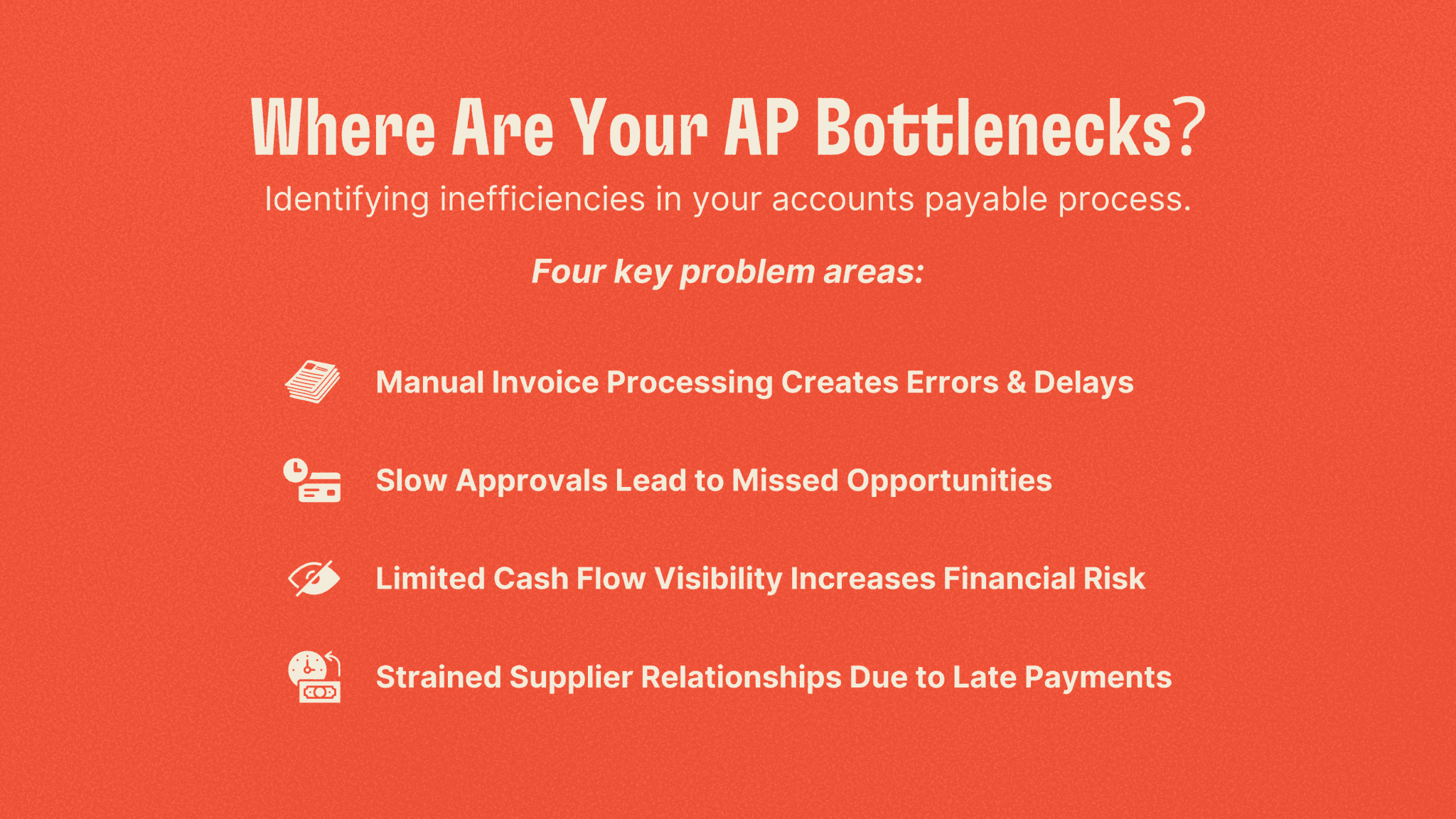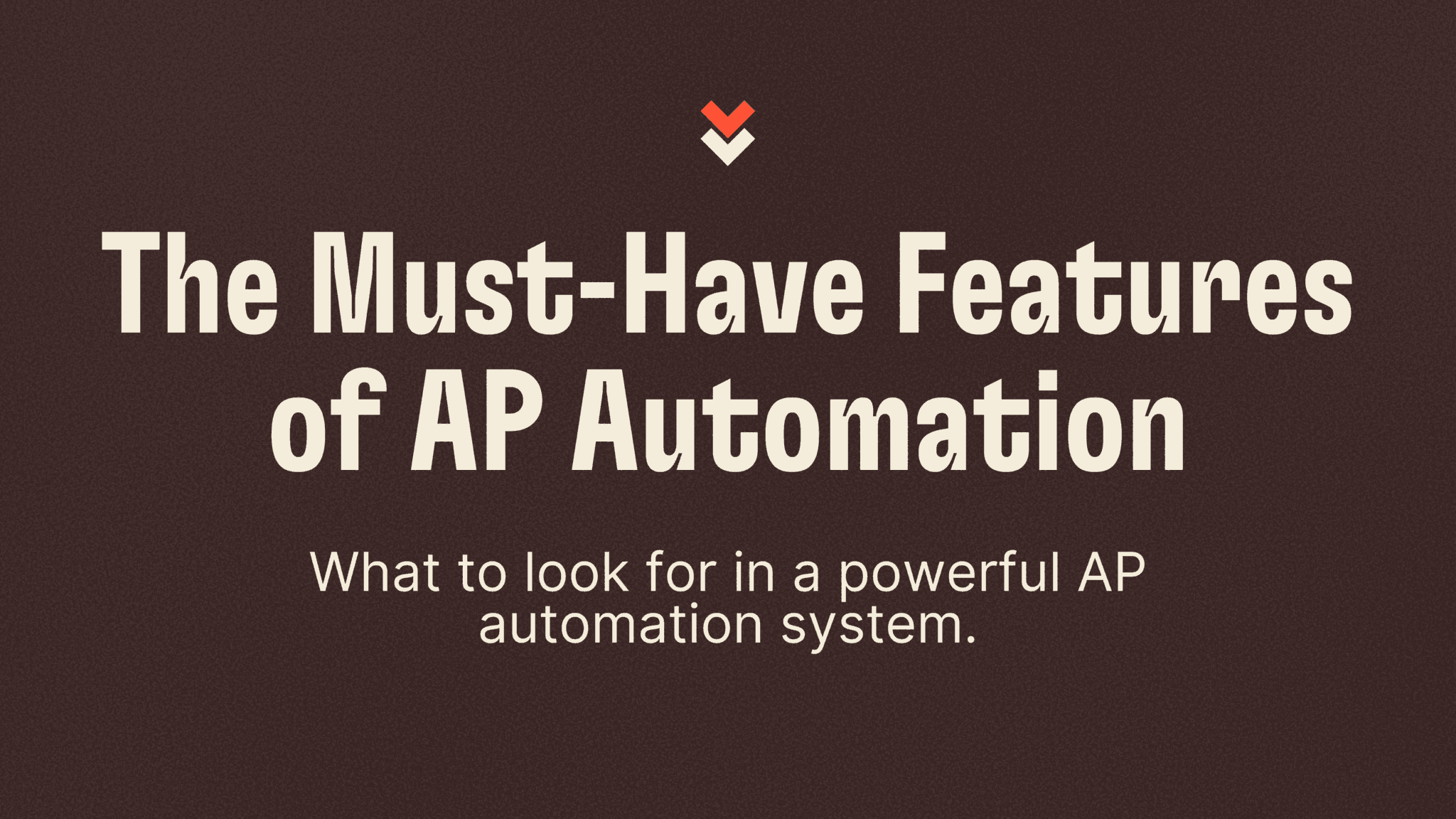How to Choose the Best Accounts Payable Automation Software for Your Business
Mar 26, 2025
Managing automated accounts payable and invoice automation should be simple—receive an invoice, approve it, and make the payment. But for most businesses...
Managing automated accounts payable and invoice automation should be simple—receive an invoice, approve it, and make the payment. But for most businesses, it’s far from straightforward.
Invoices pile up, approvals get delayed, and payments are missed. What should be an efficient financial process often turns into a bottleneck that slows operations. Businesses handling large transaction volumes, international payments, and supplier relationships face even greater complexity.
Without automated accounts payable, finance teams struggle to process invoices on time, manage approvals efficiently, and maintain cash flow visibility.
That’s why choosing the right accounts payable automation software is critical. Instead of relying on manual processes, automation streamlines workflows, eliminates errors, and provides financial control.
With many AP automation solutions and accounts payable systems available, how do you choose the right one? Here’s what to consider.
Where Are Your AP Bottlenecks?

Before evaluating ap software and invoice automation software, it’s essential to identify inefficiencies in your accounts payable process.
Manual Invoice Processing Creates Errors & Delays
Traditional AP processes rely on spreadsheets, PDFs, and email-based approvals, leading to:
Data entry errors – Manually entering ap invoice details increases the risk of typos, miskeyed amounts, and duplicate transactions, which can result in overpayments or incorrect charges.
Lost invoices – Paper-based or email-dependent invoicing systems make it easy to lose track of invoices, leading to late payments, strained vendor relationships, and possible service interruptions.
Slow reconciliation – Without invoice processing software, finance teams must manually match invoices with purchase orders and payments, delaying financial reporting and increasing the risk of errors.
With automated invoice processing software, businesses can eliminate these inefficiencies, ensuring invoices are processed faster and more accurately.
Slow Approvals Lead to Missed Opportunities
For businesses managing high-value transactions or multi-level approvals, delays in invoice authorisation can lead to:
Missed early payment discounts – Many suppliers offer discounts for quick payments, but slow approval processes mean businesses miss these cost-saving opportunities.
Late payments and penalties – Payment delays due to slow internal approvals can lead to late fees, harming supplier relationships and increasing costs.
Unpredictable cash flow – Unapproved invoices create uncertainty, making it difficult forbusinesses to plan expenses and allocate resources efficiently.
Automated approval workflows ensure that invoices move quickly through the right channels, preventing bottlenecks and unlocking financial savings.
Limited Cash Flow Visibility Increases Financial Risk
Without real-time invoice management, businesses lack visibility into upcoming liabilities. This can result in:
Unexpected cash shortages – Without proper planning, businesses may not have enough liquidity to cover invoices when payments are due, leading to last-minute borrowing or overdrafts.
Poor financial decision-making – A lack of real-time AP data makes it difficult to accurately forecast cash flow and plan for expenses.
Compliance and audit risks – Incomplete records and manual tracking make audits time-consuming and increase the risk of regulatory non-compliance.
With ap invoice automation, businesses gain real-time cash flow insights, helping them make informed financial decisions and avoid unnecessary financial risks.
The Must-Have Features of AP Automation

A strong accounts payable system should reduce manual effort, improve cash flow, and enhance financial visibility.
1. Eliminating Data Entry & Reducing Errors
A robust accounts payable automation solution should include:
Optical Character Recognition (OCR) – This technology scans invoices and extracts key details automatically, eliminating the need for manual data entry and reducing human errors.
Automated invoice matching – AP automation should match invoices with purchase orders and delivery receipts, ensuring payments are only made for verified transactions.
AI-driven technologies for fraud detection – Smart automation detects duplicate invoices, unusual payment patterns, and other red flags, reducing the risk of fraud.
By implementing touchless processing, businesses can reduce errors, speed up invoice processing, and improve accuracy.
2. Speeding Up Approvals Without Sacrificing Control
A well-structured AP automation workflow ensures faster invoice approvals while maintaining oversight.
Automated approval routing – The system directs invoices to the appropriate decision-makers based on pre-set rules, ensuring faster approvals without manual intervention.
Multi-level approval settings – Businesses can set approval hierarchies, ensuring that high-value transactions go through the necessary checks before payment.
Mobile-friendly approvals – Managers can approve invoices on the go using a mobile app, preventing delays caused by unavailable stakeholders.
These features help businesses avoid late fees, capture early payment discounts, and strengthen vendor management.
3. Making Payments More Flexible & Efficient
A complete accounts payable solution should optimise cash flow management and payment flexibility.
Multiple payment options – Businesses should have the ability to pay suppliers via bank transfers, credit cards, or international payment gateways, maximising payment efficiency.
Automated payment scheduling – The system ensures that invoices are paid on time by scheduling payments according to due dates and supplier terms.
Cash flow optimisation tools – Businesses can take advantage of credit card float periods to extend payment cycles and improve cash management.
With automated payments, businesses ensure on-time vendor transactions, reduce financial risks, and improve working capital.
Why Seamless Integration is Critical for AP Automation
Even the best accounts payable automation software will fail if it doesn’t integrate with your existing financial systems.
Essential Integrations for AP Automation:
Accounting software (Xero, QuickBooks, MYOB, NetSuite) – Ensures seamless invoice reconciliation, reducing the need for manual data entry.
ERP systems (SAP, Oracle, Microsoft Dynamics) – Provides large businesses with a comprehensive financial management solution that connects AP automation with enterprise-wide accounting.
Banking platforms – Direct integration with banks allows businesses to process payments, track transactions, and reconcile invoices in real time.
A well-integrated AP automation solution eliminates manual data transfers, improves financial reporting, and ensures smooth transaction processing. ERP integration is particularly crucial for businesses looking to streamline their entire financial ecosystem.
User Experience: Simplicity in AP Automation

The best AP automation software should be easy to use. Businesses should look for:
A simple, intuitive interface – A well-designed user interface reduces training time and makes it easy for employees to navigate the system, enhancing overall process efficiency.
Mobile accessibility – The ability to approve invoices and process payments from any device ensures business continuity and efficiency.
Reliable customer support – Access to knowledgeable support teams helps resolve issues quickly, minimising downtime and disruptions.
Software that integrates seamlessly into existing workflows maximises adoption rates and efficiency. An electronic workflow that mirrors your current processes can significantly improve user adoption and satisfaction.
Cost vs. ROI: Evaluating the Value of AP Automation
While pricing matters when selecting accounts payable automation software, businesses should focus on long-term return on investment (ROI). Investing in the right AP automation solution can lead to significant financial benefits, including time savings, cost reductions, and improved cash flow management.
Many businesses hesitate to adopt AP automation due to concerns about pricing. However, automation quickly offsets its initial cost by eliminating inefficiencies, reducing financial risks, and unlocking new savings opportunities. Understanding the full ROI of AP automation helps businesses make informed decisions and select software that offers both efficiency and financial gains.
Key ROI Considerations:
1. Time Savings: Reduce Processing Time by Up to 75%
Manual AP processes are time-consuming and resource-intensive. Every invoice requires manual data entry, multiple levels of approval, and manual payment processing, which slows down operations and increases administrative burden. AP automation eliminates these inefficiencies by:
Automating invoice capture – OCR technology extracts invoice details, reducing manual data entry errors.
Streamlining approvals – Automated workflows route invoices to the correct approvers instantly, preventing delays caused by email follow-ups and lost documents.
Enabling bulk payment processing – Instead of processing invoices one by one, AP automation allows businesses to schedule and execute multiple payments at once, saving valuable time.
With AP automation, businesses can process invoices up to 75% faster, allowing finance teams to focus on higher-value tasks such as financial planning and forecasting. This significant improvement in AP department efficiency can transform the role of the accounts payable team within an organization.
2. Cost Reduction: Avoid Late Fees and Capture Early Payment Discounts
Manual AP processes often result in missed deadlines, late fees, and lost early payment discounts. Late payments can harm supplier relationships, leading to stricter payment terms or higher costs in future negotiations. AP automation prevents these unnecessary expenses by:
Ensuring invoices are paid on time – Automated reminders and scheduled payments prevent late fees, preserving vendor relationships and maintaining credibility.
Taking advantage of early payment discounts – Many suppliers offer discounts for early payments (e.g., 2% off for paying within 10 days). AP automation identifies these opportunities and prioritises payments accordingly.
Reducing administrative overhead – Eliminating manual processing means businesses require fewer resources to handle invoices, reducing payroll costs associated with AP management.
By automating invoice payments, businesses can cut costs significantly, improving overall financial efficiency and profitability.
3. Cash Flow Improvements: Gain Better Control Over Outgoing Expenses
Cash flow is the backbone of any business, and poor AP management can create liquidity issues. Businesses must ensure they have enough working capital to cover operational expenses while avoiding unnecessary cash outflows. AP automation improves cash flow management by:
Optimising payment schedules – Businesses can strategically time payments to extend cash flow cycles, ensuring they have sufficient funds available before making payments.
Using credit card payment options – Some AP automation platforms, like Lessn.io, allow businesses to pay invoices using credit cards, even when suppliers don’t accept them. This extends cash flow cycles by leveraging credit card float periods.
Providing real-time visibility – Businesses can track outstanding invoices, upcoming payments, and available cash reserves in a single dashboard, improving financial decision-making.
By giving businesses greater control over when and how they pay suppliers, AP automation prevents cash shortages and ensures financial stability. This real-time visibility into financial data empowers businesses to make more informed decisions about their cash flow management.
Comparing Pricing Models: Subscription vs. Transaction-Based Pricing
Not all AP automation software is priced the same way. Businesses need to compare different pricing models to find a cost-effective solution that meets their needs. The two most common pricing structures are:
1. Subscription-Based Pricing
Many AP automation providers charge a fixed monthly or annual subscription fee. This pricing model is beneficial for businesses with high invoice volumes, as the cost remains predictable regardless of the number of transactions. Subscription-based pricing often includes:
Unlimited invoice processing
Fixed monthly costs, making budgeting easier
Access to all software features without additional transaction fees
This model is ideal for businesses that want to scale their AP automation without worrying about fluctuating costs.
2. Transaction-Based Pricing
Some providers charge based on the number of invoices processed or payments executed. While this model may seem cost-effective for businesses with low invoice volumes, costs can quickly add up as the business grows. Transaction-based pricing may include:
Fees per invoice processed
Charges based on payment methods (e.g., bank transfer vs. credit card)
Additional fees for integrating with accounting platforms or ERPs
Businesses should carefully assess their average invoice volume and payment activity to determine whether a flat-rate subscription or a pay-per-transaction model is more cost-effective.
Why Lessn.io is the Best Accounts Payable Automation Software
Lessn.io is a leading AP automation platform designed to simplify invoice payments, optimise cash flow, and maximise financial rewards. Unlike traditional AP automation software, Lessn.io provides:
Seamless invoice payments using credit cards – Businesses can pay invoices with credit cards even when suppliers don’t accept them, earning cashback and rewards.
Extended cash flow flexibility – With a 50+ day payment float period, businesses can optimise working capital while maintaining vendor relationships.
Automated reconciliation with Xero, MYOB, and QuickBooks – Eliminates the need for manual data entry and speeds up financial reporting.
Financial rewards – Businesses can earn AMEX, Visa, and Mastercard points on expenses, turning AP into a revenue-generating function.
Enterprise-grade security – Lessn.io includes fraud detection, audit trails, and compliance tracking, ensuring financial security.
For businesses managing large transaction volumes, international payments, and complex approval workflows, Lessn.io offers faster, smarter AP automation.

Final Thoughts: Choosing the Right AP Automation Software
Selecting the best accounts payable automation software isn’t just about eliminating paperwork—it’s about improving efficiency, accuracy, and financial control.
By identifying AP challenges, prioritising integrations, and focusing on usability, businesses can choose a solution that reduces costs, saves time, and improves financial decision-making. The right accounts payable system can transform your AP department, turning it from a cost center into a strategic asset for your business.
Ready to streamline your AP process?
Start with Lessn.io—the easy way to pay, earn, and optimise cash flow.
Continue Reading
START REWARDING YOUR HARD WORK TODAY
Join Australian businesses turning payments into rewards.




